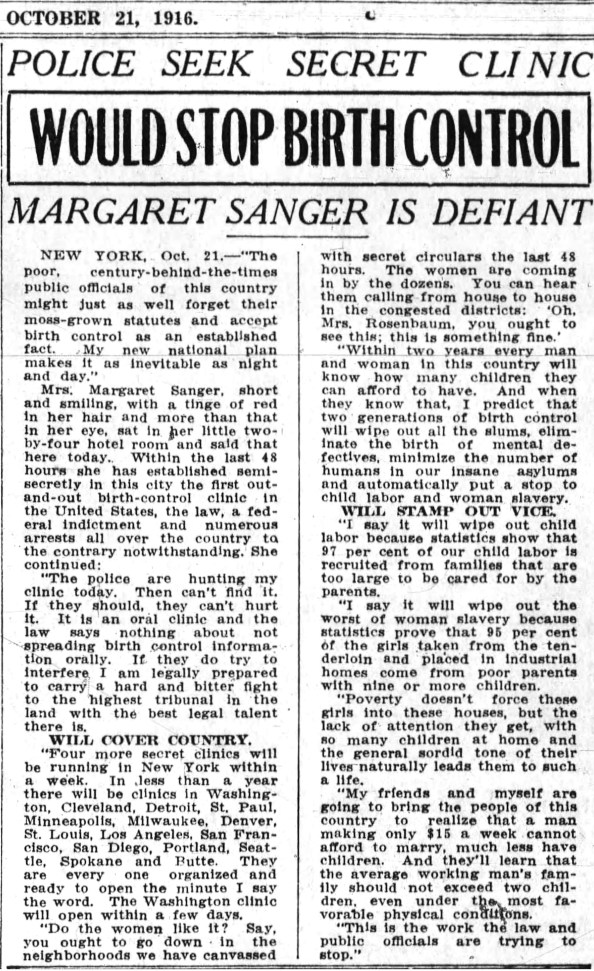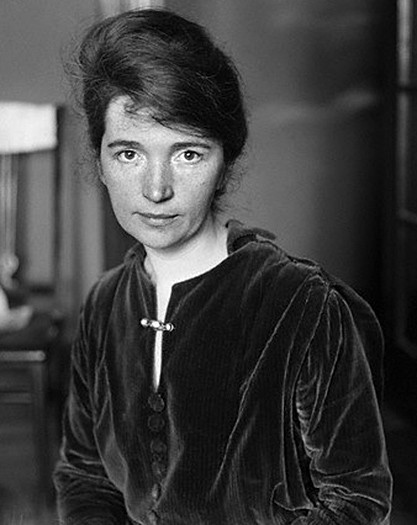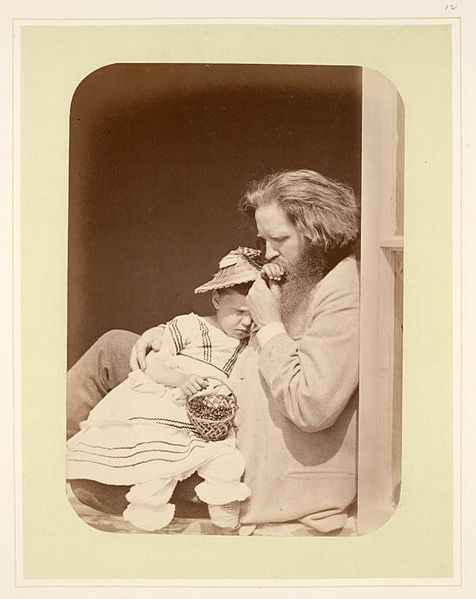Tuesday, October 18th, 2016, continued
Let me preface this second part of the story of today’s journey with full credit and a note of gratitude to Robin Pokorski, who worked with The Margaret Sanger Papers Project for a time. As with the MSPP overall, I found Pokorski’s project Mapping Margaret Sanger to be an absolutely invaluable resource. I’d made somewhat of a study of Sanger’s ideas over the last couple years but had not yet done the site research as of the time the opportunity to take this trip arose. With little time to prepare, imagine my joy and surprise when my research led me quickly to someone who had already done the mapping work! So I relied heavily on Robin’s work for all of the travel portions of this project. Please accept my sincerest thanks, Robin, wherever you are, and here’s to your continued success in all you do!
…I exit Grand Central Station, where I’ve just returned to Manhattan from the Sanger clinic site in Brownsville, Brooklyn. I follow the signs to the exit which lets me out right underneath the Chrysler Building, which stands at 405 Lexington Ave, just north of 42nd St. I’ve long been curious about this building but for one reason or another, had never made it here. It’s fully as handsome on the outside and lovely on the inside as I’ve heard. It shoots up to the sky enthusiastically and towers overhead with almost aggressive confidence and optimism. I love its Art Deco style, and I’m excited to see all the wonderful architecture and art of this period that this trip will take me to. I only wish I had a good enough camera to capture the details of the rather dimly glowing interiors. But I sacrifice camera quality for portability, and my iPad takes decent enough photos for the most part while also acting as my notepad, several books, laptop, maps and atlases, and more, all in one object the size of a slim novelette when it’s in its case. It’s just not good with low to medium interior lighting. Oh well. I love to not be heavily laden with lots of things to shuffle around.
Pokorski writes, ‘At 4.30pm on April 20, 1939, Sanger met with Bill Melon at the Chrysler Building.’ I have not been able to discover who Melon was or why she met him here yet; I await her response to my inquiry.
The walls of the lobby are lined with a beautiful wavy-patterned stone in shades of amber, rust, brown, and cream. It’s like entering into a semi-translucent, richly colored semi-precious stone held up to the early evening light. The ceilings are painted over with beautiful murals. Actually, as a sign on the wall tells me, these images are huge paintings on canvas which were subsequently glued into place. One of these murals is called ‘Transport and Human Endeavor’ and painted by Edward Trumbell. Sanger was a Socialist and worker’s rights activist for many years before she turned her focus to birth control, advocating for better workers’ protection laws, especially for women and children. She may have admired the mural’s beauty while scoffing a bit at its idealized depiction of labor.
As Sanger pointed out in Woman and the New Race, many working men enjoyed much better protections than women and children, especially those men who belonged to labor unions. But the relative paucity of workers’ protection laws and the abundance of men, women, and children desperate for jobs often made it unnecessary for employers to offer competitive wages or provide decent working conditions, and the situation of many working men, as well as that of working women and children, remained dire. It was the era of Lochner vs. New York, when ‘freedom of contract’ reigned supreme in court decisions regarding labor law and the regulation of commerce generally. Of course, the freedom of contract principle assumes that both employers and employees enter into contracts of their own free will, and therefore should have the right to do so. It’s quite easy to recognize, however, that this ideal bore little resemblance to the actual relationships between so many employers and the laboring poor Sanger worked on behalf of. It’s hard to see where free will comes in when the choice is between working backbreaking hours in miserable conditions, or starvation and homelessness for yourself and your family.
I leave the Crysler Building, then head west and south over to Park Avenue & E. 41st Street, also close to Grand Central Station, to the site of the Manhattan Eye and Ear Hospital where Sanger worked in 1902 to complete her training as a nurse. A gleaming glass highrise named 101 Park Avenue, after its address, now stands at the hospital’s former site. Sanger welcomed her assignment to this modern, well-run establishment after her ‘harsh and intense’ two years at White Plains Hospital.
It was here that she met William Sanger, her first husband, and as she put it, her ‘lover for all the world’, though their marriage didn’t last. He was a fine artist and architect, and their courtship began almost immediately after William visited the hospital with plans for the doctor’s home he was designing. The Sangers shared an intense passion for a time, and a happy marriage for a while. They had three children together, one of which died as a small child, and Sanger relished the early experience of motherhood. But over time, their marriage, which had taken them to quiet suburban Westchester, grew strained: William wanted to make a career as an artist and was often impractical about money; Sanger was discontent with the humdrum routine of domestic life after her years as a working nurse. They moved back to New York City and became active in the Socialist movement and bohemian Greenwich Village scene, and Sanger returned to her nursing career, this time in service to the poor and immigrant inhabitants of the Lower East Side. The differences in the way they wanted to live their lives proved too great over time, however, and they gradually split, finalizing their divorce in 1921.

Bromley’s 1902 atlas showing location of Manhattan Eye and Ear Hospital, from the maps collection of the NY Public Library
William was a brave and loyal partner to Sanger, at one time jailed on her behalf by Anthony Comstock in 1915 for obscenity. Comstock, a special agent of the U.S. Postal Service who helped craft laws to zealously enforce his own strict views on public morality, tricked William into handing over, or in Comstock’s words, ‘distributing’, one of Sanger’s pamphlets on reproduction, health, and birth control. It included a description of two venereal diseases, gonorrhea and syphilis, and Comstock had helped make it legally obscene to name these diseases as well as to tell women how they could prevent pregnancy with any method other than abstinence, even in the context of a health care pamphlet. After arresting William, Comstock offered him a choice: he could tell him where Margaret Sanger was hiding out (she had fled to Europe the year before to avoid prosecution) or he could stand trial. William opted for the latter and was jailed because he refused, on principle, to pay the fine.
Over the years, Sanger regretted the way her relationship with William fell apart, blaming herself for much of what went wrong though she also thought she could have done little else. She wrote a very tender letter to him in 1919, directing that it be given to William after her death. Since she outlived him by five years, he never read it. She wrote,
‘…My life seems to have been in the hands of forces I could not control. My early days at the hospital seemed so hard & cruel at the time, but today I see how necessary they were for the accomplishment of the work I am doing today.
My marriage to you and our love and the coming of the children, the saving for a home — the building of the house — the seeking, shifting, changing, interesting life all today have meaning & full value to me in this cause of humanity to which my life is dedicated.
Often I have felt your loneliness & sorrow — often I would like to seek you & fling my arms about you & hold your aching head to my heart to tell you of my tenderness for you and my love — but — Forces stronger than physical desire — stronger than personal love held me to my task to the work I have undertaken to do. But I want you to know this — for I have told it to many — that you are to me the lover of all the world — Your love for me beautified my life and made possible the outlook on love & passion & sex — which has given me the courage & strength to go forth to do.
For this I owe you much and though my love for you is big & broad & tender it is the same today as when first we decided to go the path of life together. It has never changed. Sometimes I think it was not to be that I should love too intensely…’
You can read this letter in full, and a brief but very good account of the talented and principled William Sanger, at this website dedicated to his art and legacy.
Then I go to the lovely New York Public Library, where I request a copy of Ellen Chesler’s biography of Sanger. Since it’ll take about 30-45 minutes and I’ll need some time in the maps room, I decide to come back tomorrow and stay awhile.

280 Madison Ave, Manhattan NYC, my photo on the left, and to the right, as it looked in 1945. Photo by Wurts Bros, courtesy of the Museum of the City of New York
I head one block to the southwest to 280 Madison Ave at E 40th St, where, Pokorski notes, Sanger lived for a short time. She ‘moved from 280 Madison Avenue in late April, 1931, [and it’s] uncertain when she moved in or where she moved to’. The building looks more or less the same as it did then, according to a photo (above) of the same building in 1945, except that the ground floor has had a new ‘face’ put on at some point, of straight bands of gray-tan stone instead of the arched arcade it once featured.

Margaret Higgins Sanger reading, Jan 1916 by Bain News Service, public domain via Library of Congress. I found a photo of Sanger at about the time she lived here at 280 Madison, but it’s not public domain. You can find it at Getty Images
Sanger was almost certainly living here when she published her ‘Comments on the Pope’s Encyclical‘ in Birth Control Review in February of 1931, and probably wrote it here, too. It’s a succinct version of at least two much longer critiques of Pope Pius XI’s Dec. 30, 1930 encyclical Casti Connubii. I’ll explore many of the ideas contained in Casti Connubii as well as Sanger’s responses to it in the context of her ideas about human sexuality and social welfare in another piece I plan to publish very soon. Sanger’s three main points, as contained in her brief ‘Comments’, are as follows. 1) The Pope never explicitly commands his followers to have as many children as they can, contrary to the beliefs of many who oppose family limitation. That’s a good thing, because even if God exists and actually commanded the human race to “Increase and multiply and fill the earth,” that commandment has been fulfilled already. Now it’s up to us to make sure to have enough room left over to give the multitudes that exist a happy and healthy life. 2) While the Pope is correct that both love and procreation are two of the primary purposes of marriage, the latter is not essential to it. People often marry who can’t have children, and people remain married when they can no longer have more and their children have left the home, no longer requiring support. Clearly, marriage has many other purposes, which is also true of sex itself. Therefore, the Pope is wrong to propose an inextricable link between sex, marriage, and procreation. 3) The Pope declares that birth control is wrong because it frustrates nature. Yet so does abstinence, which the Pope recommends, to say nothing of the numerous ways we frustrate nature every day: shaving our faces and cutting our hair; eradicating germs with soap, water, and medicines; building shelters to protect ourselves from the natural elements, and so on. Civilization itself is one giant web of ways in which we frustrate nature or bend it to our will. The latter argument, as is evident from her sarcastic tone as well as from her other critiques of this encyclical, Sanger considers downright silly.
There are several more sites I visit today and since so there’s much more to tell, I’ll break here, and pick up my tale shortly. To be continued….
Listen to the podcast version here, on Google Play, or on iTunes
Ordinary Philosophy and its Traveling Philosophy / History of Ideas series is a labor of love and ad-free, supported by patrons and readers like you. Please offer your support today!
~~~~~~~~~~~~~~~~~~~~~~~~~~~
Sources and Inspiration:
‘About Sanger: Biographical Sketch‘, from The Margaret Sanger Papers Project at New York University.
‘Anthony Comstock‘. In Wikipedia, The Free Encyclopedia.
Chesler, Ellen. Woman of Valor: Margaret Sanger and the Birth Control Movement in America. New York: Simon & Schuster, 1992
Eig, Jonathan. The Birth of the Pill: How Four Crusaders Reinvented Sex and Launched a Revolution. W.W. Norton & Company, New York, 2014.
Labor History Timeline: California and the United States by California Assembly Committee on Public Employees, via the Los Angeles Community College District website
‘Lochner v. New York, 1905‘, from Landmark Cases: A C-Span Original TV Series, 2015
Pius XI. Casti Connubii. Encyclical of Dec. 30th, 1930
Pokorski, Robin. ‘Mapping Margaret Sanger‘ from The Margaret Sanger Papers Project at NYU
Regan, Margaret. ‘Margaret Sanger: Tucson’s Irish Rebel.‘ Tucson Weekly, Mar 11, 2004.
Sanger, Margaret. ‘Comments on the Pope’s Encyclical‘, Birth Control Review, Feb. 1931, 40-41
Sanger, Margaret. Margaret Sanger, an Autobiography. Cooper Square Press: New York 1999, originally published by W.W. Norton & Co: New York, 1938
Sanger, Margaret. The Pivot of Civilization, 1922. Free online version courtesy of Project Gutenberg, 2008, 2013
Sanger, Margaret. Woman and the New Race, 1920. Free online version courtesy of W. W. Norton & Company
‘William Sanger: About‘, from williamsanger-art.com
Wurts Bros. ‘280 Madison Avenue and 40th Street, S.W. corner. Office building.’ Photo, courtesy of the Museum of the City of New York






























